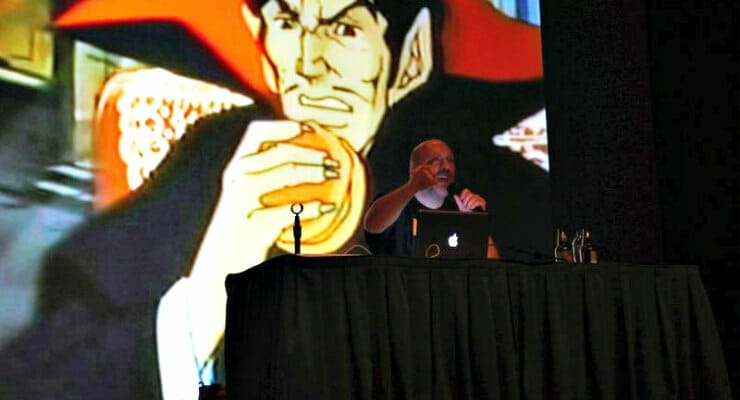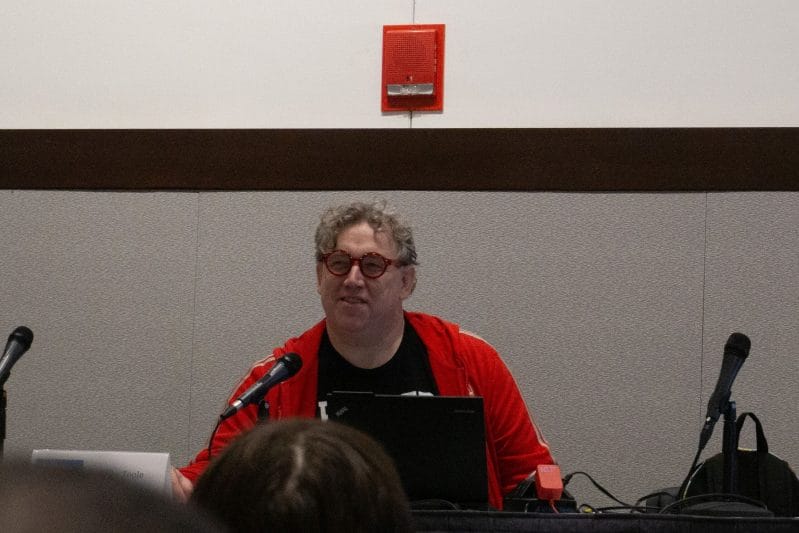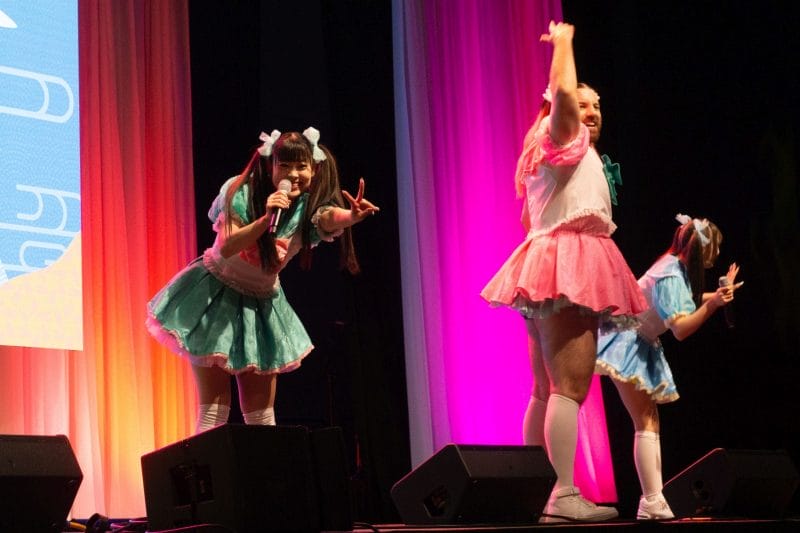 Host: Brian T. Price
Host: Brian T. Price
You know, the early days as an anime fan are pretty damn sweet. A smorgasbord of incredible shows stretches ahead almost endlessly, with the best and brightest shows of today available at a moment’s notice. One-Punch Man, Sword Art Online, and Madoka Magica can all be had with the click of a mouse or the tap of an app icon. The list of classics, from Sailor Moon to Cowboy Bebop, awaits as a ceaseless parade of brilliance and artistry.
With this in mind, it’s easy to see anime as the medium above all others. It’s easy to be sucked into that vortex of bliss, where the medium becomes a precious cinnamon, too pure for this world gone mad.
After all, anime could never be bad… right?
For seventeen years, Brian T. Price has taken on the mantle of the truth-teller. He’s made it his duty to show these bright-eyed newcomers the error of their ways, and to put the fear of God into those who’ve been around the block a few times. Each season, he drags a selection of shows from the great dumpster fire and slams them down for the world to see, so they can marvel and recoil at their grotesquery. All the while, he brings his own brand of snark and dry humor, as he delightfully skewers the works he’d worked so hard to unearth.
Whether it’s a love of the grotesque, a masochistic streak, or straight-up Stockholm syndrome, thousands of fans line up to catch the show every year. Some go it alone. Others, hereby referred to as the horribles, drag their friends as helpless lambs to the slaughter. Over the years, the crowds have grown steadily, from a humble panel, to a headlining act that takes up two full hours in the spacious Hall D.
This year, Price opted to do something a bit different. I spoke with Price before the panel, and he noted that he was taking the con’s theme of “Retro” firmly into account this year. This could even be felt in the build-up, as a countdown timer ticked mercilessly down to the start of the panel. Shortly after the clock began to tick, a familiar cacophony of alarm bells echoed through the room. The crowd burst into cheers as the iconic “tick tock” of Roger Waters’ bass began its rhythmic back beat for Pink Floyd’s Time.
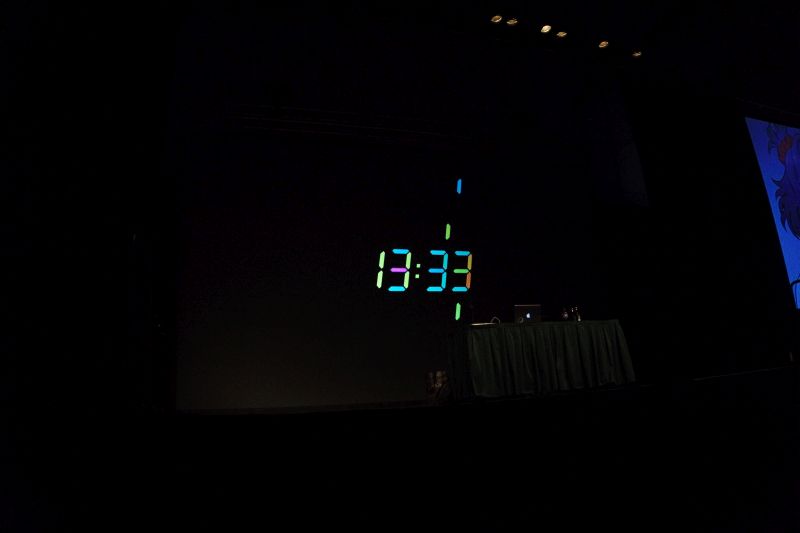
The room quickly began to settle in, remaining still silent as the song ended, giving way to Rush classic Time Stand Still. The crowd murmured with excitement, wondering what awful exhibitions Price would have on display this evening. With just three minutes and twenty-two seconds remaining, Rocky Horror classic Time Warp kicked up on the sound system. You could hear part of the audience burst into song as the chorus kicked up. Observant attendees would catch a glimpse of the con staff starting to dance a little as they direct folks to their seats.
All the while, the seconds ticked away…
At the ten-second mark, the crowd counted down in unison, erupting in cheers and applause as the timer reached zero. Soon after, an announcer kicked up over the speakers, hyping the crowd up. Her final question, “are you ready for pain?” was met with a deafening roar. Onstage, the lights flashed like lightning, each flicker punctuated by a satisfying bassy boom. Amid this, Price took to the stage, clad in Rush T-shirt.
Truly, the badness was upon us.

This evening would play out a bit differently from the previous years, though. Rather than commence with the awful, he’d lead of with a “Trilogy of Childhood Terror.” These weren’t necessarily bad properties, mind you, but as Price noted, they’re “bad for you if you’re five fucking years old!”
This led to a brief recounting of events that happened in 1977, when Price celebrated his fifth birthday. Pinwheel (later Nickelodeon) made its grand début, and Star Wars enraptured moviegoers across the world. The Atari VCS brought the video arcade into households, and the first TCP/IP protocols were defining the groundwork for the Internet. Elvis passed away, David Bowie proved we could be heroes (if only for a day), and Queen was belting out We Are the Champions.
1977 also saw the début of Wizards, an R-Rated fantasy film from animation legend Ralph Bakshi. Price fondly recounted being dragged out of the theaters ten minutes into the feature, shortly before launching into the feature. The clip opened with a hanging man, which pans to Necron 99 riding his lizard mount across a wasteland.
The film jumped from one shocking scene to the next, from fairy prostitutes to outright genocide. Some cringed, others laughed uncomfortably at the scene. During the spectacle,Price sardonically belted out “Come on! It’s just for kids!” He moved on to the film’s “punchline”, in which force for good and nature, Avatar, pulls out a gun to finish off the villainous Blackwolf. The room erupted into peals of laughter at the sheer absurdity of the scene.
With Wizards concluded, it was time to shift to a more family friendly film. Well… supposedly. The next selection from the great dumpster fire was The Mouse and His Child, a Sanrio co-production that was supposedly targeted toward families. Price explained the feature as “Toy Story, but the whole world is Sid’s Bedroom.”
Throughout the feature, Price’s snark was on point, with a sense of sarcastic humor that was as biting as it was hilarious. Audible chuckles could be heard through the room as he commented on the soul-stealing expressions on dolls, or the “’50s sitcom monotone” of the father mouse character.
He continued to skip from one disturbing scene to the next, explaining the subtleties of the feature’s fucked up world. From the overt slavery of toys by Manny the Rat, to the turtle who ponders the nature of infinity. This gave way to a classical exercise in psychedelic film known only as “The Last Visible Dog” scene.
After a final snippet from the film, which I won’t spoil (really, hunt this feature down, folks), Price set the stage for the final film in the Trilogy of Child Terror. This time, it was Raggedy Ann & Andy: A Musical Adventure. For the uninitiated, this is another Toy Story-ish groove, which doubled down on psychedelic surrealism to produce something that was akin to pure nightmare fuel.
As Price put it, “I think these animators hate children.”
Richard Williams (Who Framed Roger Rabbit) directed this animated hour of horrors, which featured Grease star Didi Conn as Raggedy Ann.
Throughout the feature, Price continued slinging sardonic barbs and calling out just how goddamn weird the feature was. He made exaggerated facepalms at the end of Candy Hearts and Paper Flowers, when Andy shoves a gift from Raggedy Ann into his pants. Price skewered the cast for pointing out the obvious, and made a few fun Akira comparisons in the film’s infamous Greedy Scene.
Once the feature was over, and the Trilogy of Child Terror was over, Price stood before the crowd. It was time to pull out the worst of the worst – the titles that scarred the psyches of younger fans, and made the veterans question their very reality. Since this was the first time for a lot of folks, it was decided that the most deranged of the bunch, the repeat visitors, make the decision.
The crowd overwhelmingly chose Garzey’s Wing: an OVA series by Yoshiyuki Tomino (Gundam), first shown at Anime Boston 2012. Price told a story about the title, how he tried cutting a digest for the event that year, only to be unable to find a single thing to excise. He showed it to his friend Dave at DC Comics, who replied “Don’t you cut a thing! Not one goddamn thing!” Thus began three straight years of infamy.
Rather than show the whole episode, though, Price loaded a digest he prepared for 2013, which showcased the most absurd moments. Throughout the feature, giggles turned to delighted laughter, mixed with the occasional cry of “what?!” from those who weren’t properly warned.
Those poor bastards.
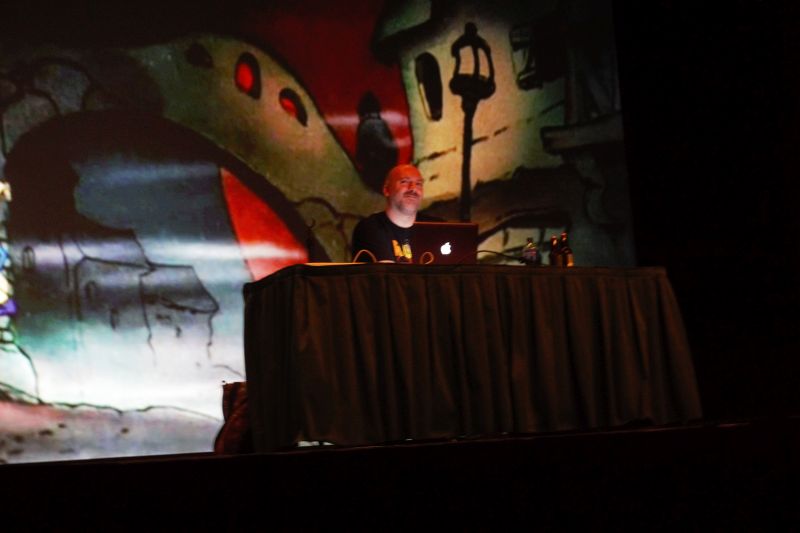
Folks snickered at Zagazoa’s constant crashing of his mounts (“he used to park cars for a living!”), and they collectively recoiled as Chris used fluid from a fairy’s still-beating wings to coat his arrows in explosive powder.
Before long, the final screen faded to black again. The next selection would make mecha fans cry salty tears.
Enter: Magnos the Robot.

For the uninitiated, Magnos is a poorly dubbed adaptation of Magne Robo Gakeen. The feature quickly gained infamy due to its mashing of every imaginable trope together into one horribly muddled mess. The characters transform, they pose, they do backflips into the robot. They fly ships into a robot that was launched separately. On top of this, characters are given nonsensical names, like Xerxes “Tire-Iron” Dada (I kid you not), Sir Nevers, and Lady Ester.
Audible cries of confusion could be heard through the feature’s over-the-top transformation sequence, which sees:
- The two main characters posing to transform
- The newly leads synchronously backflipping into two separate aircrafts, which launch into the sky
- The robot parts for the main Magnos unit firing out of the base to form the main robot
- The two leads jumping out of their ships to meet each other mid-air.
- The two leads, once they meet, getting some mid-air Hunka Chunka to turn into a belt buckle, which powers Magnos the Robot
Did I mention that Magnos can’t fly? Because Magnos can’t fly. Instead, he needs the two standalone crafts to serve as propulsion units.
In short: it’s a delicious train wreck, made even more priceless by a montage Price cut together, which sets the most outlandish segments to the Benny Hill theme.
Thankfully, the horrors of Magnos didn’t last long. Instead, it was time to delve into the dumpster of the occult, with Dracula: Sovereign of the Damned. This Marvel Comics co-production is delightfully dumb, with a cast of vampire hunters that can only be called the “Fucking Idiot Squad.” It was at this point, that Price unveiled the unofficial drinking game for the film:
- Every time a human gets an eye-gleam, take a drink.
- Every time an animal with more than two legs gets an eye-gleam, chug!
Even the heaviest of drinkers won’t last very long, sadly.
Price gleefully needled the very core of the film, from Quincy Harker’s nonsensical reasons for not murdering a depowered Dracula, to the Lord of Darkness’s idiocy with his former partners. Then there’s the whole freaking year that the hunters waste with no tangible progress.
Yeah… they’re probably not cut out for this job.
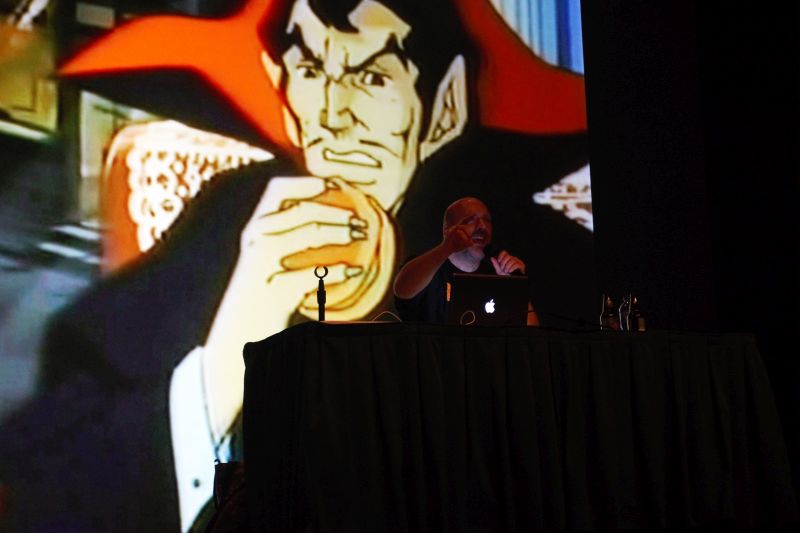
Still, the crowd howled with laughter when Harker tried to prove his sword skills from his wheelchair, as they did when the scene cut to Dracula mugging a guy and buying a burger.
As the feature closed out, Price stood before the room again. Time was beginning to grow short, so the topic turned to Adaptational Agony. These are features which were generally based on properties for adults, and adapted to kid’s shows
Hanna Barbera’s Godzilla
This unfortunate series had the fortune of introducing Godzooky, the Scrappy Doo of the Godzilla universe, into the world.
Rambo
The Governator
The crowd popped into cheers with this one. For the uninitiated, The Governator was one of the most self-serving shows to ever be produced – an ego stroking series that depicts Arnold Schwarzenegger as a cyborg superhero. The series was quickly canned once his extramarital affairs came to light.
https://www.youtube.com/watch?v=du26YfnJLhM
The Doozy Bots!
Before you ask: Yes, those are Gundams. Yes, that’s a Sunrise license. Yes, you can feel sad for this one.
By this point, the night had grown late, and midnight was closing in fast. There was time for one last feature, and Price was determined to close the evening out with a literal bang.
He loaded up a classic: 1981’s The Monster of Frankenstein. Well, the last few moments, which see the climactic death of the Monster, which is followed by by a moment that can only be described as “a bang.”
And with that, the night came to a close, as a few “Moments of Zen” played on the monitors.
As folks filed out of the room, excited chatter could be heard. Folks discussed what took worst of the night, and a few attendees jokingly cursed their so-called friends for dragging them there. It was a night of the bad (and bad for you), given new life by wonderfully snarky commentary and a true sense of community.


